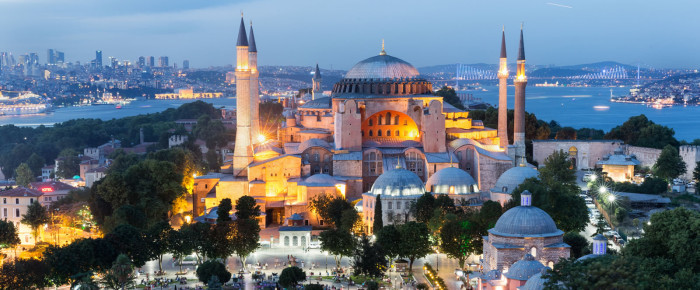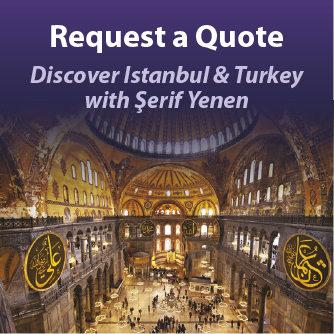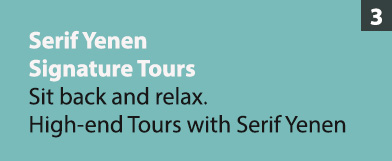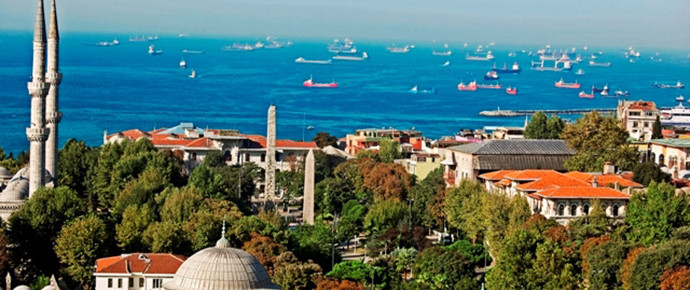Ayasofya (Hagia Sophia) Private Tour

The Hagia Sophia was probably the largest building on the world’s surface, barring the Egyptian Pyramids, or the Great Wall of China. For many centuries it was the largest church and today is the fourth largest in the world after St. Paul’s in London, St. Peter’s in Rome and the Duomo in Milan. The great Ottoman architect Sinan, in his autobiography, says that he devoted his lifetime in the attempt to surpass its technical achievements.
It was dedicated to the Hagia Sophia which means the Divine Wisdom, an attribute of Christ.
Today’s Hagia Sophia is the third building built at the same place. The first one was a basilica with a wooden roof and was built in 390 AD. This original church Megale Ecclesia (Great Church) was burned down in a rumpus in 404. Theodosius replaced it with a massive basilica which was burned down in the Nika Revolt against Justinian in 532. Justinian began rebuilding the Hagia Sophia in the same year. The architects were two Anatolian geniuses, Anthemius of Tralles, an engineer and a mathematician and Isidorus of Miletus, an architect. They started collecting materials from all over the empire. In the construction ten thousand workers worked under the supervision of one hundred master builders.
Justinian reopened it in 537 entering the Hagia Sophia with the words “Solomon, I have surpassed you!”.
 Because the building is on a fault line in an earthquake zone and the city passed through many riots and fires, the Hagia Sophia was destroyed and underwent restorations several times.
Because the building is on a fault line in an earthquake zone and the city passed through many riots and fires, the Hagia Sophia was destroyed and underwent restorations several times.
Throughout Byzantine history, the Hagia Sophia played an important role as emperors were crowned and various victories were celebrated in this remarkable building. The Hagia Sophia even gave refuge to criminals.
Another major event during the Byzantine period was the removal of all religious images from the church in the iconoclastic period. During the Fourth Crusade in 1204, the church was pillaged and some disgusting events took place in the Hagia Sophia. After conquering Constantinople in 1453, Sultan Mehmet immediately went to the Hagia Sophia and ordered that it be converted into a mosque. This was done by adding the Islamic elements such as minarets, the mihrab and the minber all of which were appropriately positioned to face toward Mecca, 10 degrees south of the main axis of the building. The architect Sinan was also assigned to make some restorations and add Islamic elements to the building. Buttresses were added in the Ottoman period. Two huge marble jars were brought from Pergamum in the 16C and probably used to keep oil for candles. The eight round wooden plaques at gallery level are fine examples for Islamic calligraphy. The names painted on these plaques are Allah, Prophet Mohammed, the first four Caliphs Ebubekir, Omer, Osman and Ali, and the two grandsons of Mohammed, Hasan and Huseyin.
In time Ayasofya became a complex consisting of tombs, a fountain, libraries, etc. It has been thought that when Turks converted the church into a mosque, all the pictures were covered which is not correct. According to the narration of travelers, pictures were still standing but figures’ faces were covered.
Ayasofya was used as a church for 916 years and as a mosque for 481 years. In 1934, by the order of Mustafa Kemal Ataturk, it was made a museum and has since been open to visitors.
Architecture
The Hagia Sophia has a classical basilica plan and the main ground plan of the building is a rectangle, 70 m / 230 ft in width and 75 m / 246 ft in length. The central space of the Hagia Sophia is divided on both sides from the side aisles by four big piers and 107 columns (40 downstairs, 67 upstairs) between them. The space is covered with a huge dome which is 55.60 m / 182 ft high. The dome, due to earthquakes and restorations, is slightly elliptical with a diameter of 31.20 m / 102 ft on one axis and 32.80 m / 107.60 ft on the other.
Mosaics
Most of the mosaics are from periods after the iconoclastic period. Whitewash or plasters either of the iconoclastic or the Islamic period helped to protect the mosaics. Mosaics of major importance are as follows:
In the inner narthex above the main entrance, also called the Imperial Gate, there is a 10C mosaic depicting Jesus as pantocrator seated upon a jeweled throne, dressed like an empire, and making a gesture of blessing with his right hand. In his left hand he is holding a book with an inscription of these words: “Peace with you, I am the light of the world.” On both sides of Jesus Christ are two medallions. The Virgin Mary on the left and an angel with a staff on the right. Emperor Leo VI is depicted kneeling in front of Jesus.
On the pendentives are depicted winged angels with covered faces. The ones in west pendentives are imitations in paint from Fossati’s restoration.
Above the main apse is the mosaic depicting the Virgin Mary with the infant Jesus. She is sitting on a bench with her feet resting on a stool. Her right hand is on her son’s shoulder and her left upon his knee. Jesus is raising his right hand in blessing and holding a scroll in his left hand.
The galleries; the 13C mosaic of the Deesis scene, Jesus as the pantocrator flanked by the Virgin Mary and Saint John the Baptist who are shown interceding with him on behalf of mankind.
At the far end of the last bay in the south gallery is a mosaic showing Christ enthroned with his right hand in the gesture of benediction and the book of Gospels in his left hand. On the left is the figure of the 11C Byzantine Emperor Constantine IX Monomachus offering a money bag and Empress Zoë holding a scroll on the right. The emperor’s face in the mosaic was changed each time Zoë changed her husband. Constantine IX was Zoë’s third husband.
To the right of the mosaic of Zoë there is a 12C mosaic showing the Virgin Mary with the infant Jesus flanked by Emperor John II Comnenus offering a bag of gold and red-haired Empress Eirene holding a scroll. At the extension of the mosaic on the side wall is the figure of Prince Alexius.
At the end of the inner narthex, before going out to the courtyard (today’s exit) stands the 10C beautiful mosaic: The Virgin Mary with the infant Jesus in her lap, on one side Emperor Constantine offering a small model of the city as he is accepted as the founder, on the other side Emperor Justinian offering the model of the Hagia Sophia as the emperor who had it built.
Iconoclasm (726-843 AD)
Iconoclasm, an ancient Greek word that means “image-breaking,” refers to the religious doctrine that forbade the veneration of images (icons) of Christ and the saints in Christian churches.
In 726 AD, Emperor Leo III ordered the image of Christ at the Chalke Palace in Constantinople to be destroyed. In the following years, other measures were taken to suppress the veneration of images.
Empress Theodora, however, presided over the restoration of icon veneration in 843 AD, an event still celebrated by the Orthodox Church as the Triumph of Orthodoxy.
The iconoclastic movement was motivated by a variety of factors that possibly included Moslem influences, as well as the concern that the cult of icons was a form of idolatry. The Council of Nicaea also specified that images should be venerated but not worshipped, since worship belongs to God alone and the worship of icons would mean idolatry.
Read more





